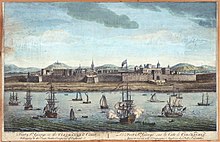Subedar
This article has multiple issues. Please help improve it or discuss these issues on the talk page. (Learn how and when to remove these messages)
|

Subedar (Template:Lang-ur) is a historical rank in the Nepal Army,Gorkhali Sena,Indian Army and Pakistan Army, ranking below British commissioned officers and above non-commissioned officers. The rank was otherwise equivalent to a British captain.सुबेदार नेपाली सेना को एउटा पद हो । In Nepalese Army/गोर्खाली सेना Subedar=सुवेदार= Warrant Officer = 1 Platoon 2IC
History

These native Subedars have the knack of tramping upon us and extorting what they please of our estate from us...they will never forbid doing so till we have made them sensible of our power.
Thomas Pitt, (1699)[2]
Origin
In British India, subedar or subadar was the second highest rank of enlisted Indian soldiers. It was derived from subahdar, the governor of a province in the Mughal Empire and the Maratha Empire. A subedar is senior to a naib subedar and junior to a subedar major.
It was introduced in the East India Company's presidency armies (the Bengal Army, the Madras Army and the Bombay Army) to make it easier for British officers to communicate with native troops. It was thus essential for subedars to be fluent in English.
Until 1866, the rank was the highest a non-European Indian could achieve in the army of British India. A subedar's authority was confined to other Indian troops, and he could not command British troops.
Before the 1947 Partition of India and the independence of India and Pakistan, subedars were known as Viceroy's commissioned officers. After 1947 this term was changed to junior commissioned officers.
After independence
After independence, which came in 1947 with the Partition of India, the former Indian Army was divided between India and Pakistan. In the Pakistan Army, the rank has been retained, but the ribbon is now red-green-red. After Bangladesh separated from Pakistan, the Bangladesh Army also retained the rank, changing the ribbon colours to red-purple-red, but in Bangladesh the title of subedar was changed in 1999 to senior warrant officer.
Insignia
Until 1858, subedars wore two epaulettes with small bullion fringes on each shoulder. After 1858, they wore two crossed golden swords, or, in the Gurkha regiments, two crossed golden kukris, on each side of the collar of the tunic or on the right breast of the kurta. After 1900, subedars wore two pips on each shoulder. A red-yellow-red ribbon was introduced under each pip after World War I. After World War II, this ribbon was moved to lie between the shoulder title and the rank insignia (two brass stars on both shoulders).
Hyderabad state
In the Princely State of Hyderabad under the Nizam, the top rank of administrators and tax collectors were called Subedars.
References
External links
- www.Bharat-Rakshak.com/Army/Ranks.html - Illustration of various military insignias including three subedar insignia designs.
